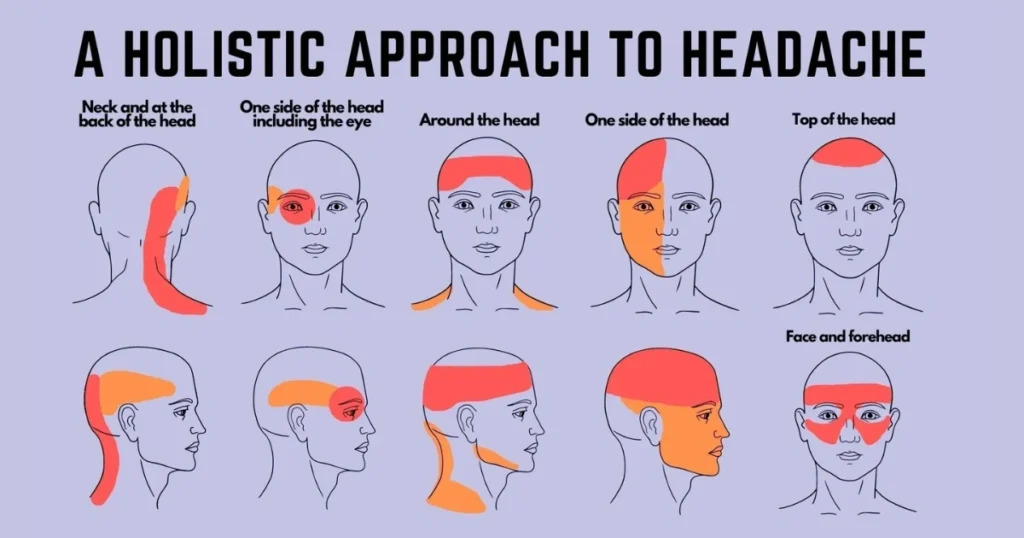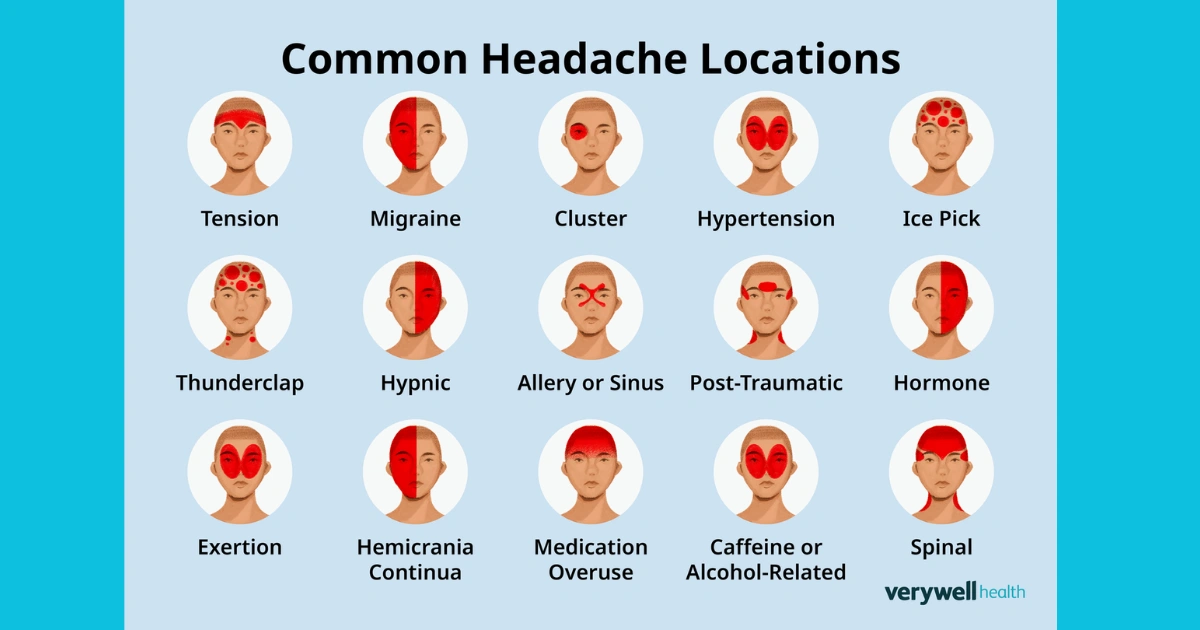Headaches are one of the most widespread health complaints, affecting people of all ages and lifestyles. While occasional discomfort can often be managed with rest or hydration, certain types of headaches can indicate underlying health conditions or require targeted treatment. Understanding the specific type of headache you are experiencing is the first step toward finding effective relief.
This guide explores 15 of the most common types of headaches, their symptoms, possible causes, and practical tips for managing them.
1. Migraine
Migraines typically involve a throbbing pain on one side of the head, often concentrated around the eye or temple. They can last for hours or even days and may be accompanied by nausea, light sensitivity, and visual disturbances known as auras. Triggers can include hormonal changes, certain foods, stress, or lack of sleep.
2. Tension Headache
The most common type of headache, tension headaches produce a tight, band-like pressure across the forehead and back of the head. They are often related to muscle strain, poor posture, or prolonged screen time. Stress management, regular breaks, and gentle stretching can help reduce episodes.
3. Hormonal Headache
Linked to fluctuations in estrogen levels, hormonal headaches often occur during the menstrual cycle, pregnancy, or menopause. They usually present as side-specific pain and may worsen with certain triggers like caffeine withdrawal or stress.
4. Exertion Headache
Physical activities such as intense exercise, heavy lifting, or even coughing can trigger exertion headaches. They usually cause pain throughout the head and can last from minutes to hours. Staying hydrated and pacing physical activity may help prevent them.

5. Cluster Headache
Cluster headaches are severe, recurring headaches that appear in cycles or “clusters.” They cause intense pain around one eye, often accompanied by redness, tearing, or nasal congestion. Episodes may last weeks or months before disappearing for extended periods.
6. Sinus or Allergy Headache
These headaches are caused by inflammation in the sinuses due to infection or allergic reactions. They create a deep, constant pain in the cheeks, eyes, and forehead, often worsening when bending forward. Treating the underlying sinus or allergy issue is key to relief.
7. Caffeine Headache
Both excessive caffeine intake and sudden caffeine withdrawal can cause headaches, typically felt in the temples and forehead. Reducing caffeine gradually instead of stopping abruptly can help prevent symptoms.
8. Rebound Headache
Overusing pain medication for headaches can ironically lead to more headaches. Known as medication overuse headaches, they cause persistent, general pain. The best approach is to consult a healthcare provider about safely tapering off the medication.
9. Hemicrania Continua
This rare headache disorder involves constant pain on one side of the head that can vary in intensity. It often responds well to specific prescription medications.
10. Hypertension Headache
High blood pressure can cause headaches, particularly a pressure sensation at the back or sides of the head. If accompanied by blurred vision, chest pain, or shortness of breath, seek medical attention immediately.
11. Post-Traumatic Headache
A head injury can lead to headaches that persist for days, weeks, or even months. They may feel localized at the site of injury or spread across the head. Medical evaluation is important to rule out complications.
12. Spinal Headache
A drop in cerebrospinal fluid pressure—often following a spinal tap or injury—can cause pain at the base of the skull and neck. Lying down may provide temporary relief, but medical treatment is often necessary.
13. Thunderclap Headache
A sudden, intense headache that reaches peak pain within seconds is a medical emergency. It may signal a serious condition such as a brain hemorrhage or aneurysm. Immediate medical attention is critical.
14. Ice Pick Headache
These headaches cause sharp, stabbing pain in a very specific spot on the head, lasting only seconds. While they are usually harmless, frequent episodes should be discussed with a doctor.
15. TMJ-Related Headache
Issues with the temporomandibular joint (TMJ) can cause headaches that radiate from the jaw to the temple. Teeth grinding, jaw clenching, or arthritis can contribute to this type of pain.
Tips for Managing and Preventing Headaches
- Maintain a regular sleep schedule.
- Stay hydrated throughout the day.
- Limit caffeine and alcohol.
- Practice relaxation techniques like meditation or yoga.
- Use ergonomic furniture to improve posture.
- Keep a headache diary to identify and avoid triggers.
FAQs About Headaches
1. When should I see a doctor for a headache?
Seek medical attention if your headache is sudden and severe, occurs after a head injury, or is accompanied by neurological symptoms like vision changes, confusion, or weakness.
2. Can dehydration cause headaches?
Yes. Even mild dehydration can lead to headaches. Drinking adequate water daily can help prevent them.
3. Are headaches a sign of serious illness?
While most headaches are benign, some can be symptoms of serious conditions like high blood pressure, infections, or brain injury. Persistent or unusual headaches should be evaluated by a healthcare professional.
4. What foods can trigger headaches?
Common triggers include processed meats, aged cheeses, artificial sweeteners, and foods high in MSG.
5. Can stress cause daily headaches?
Chronic stress is a major trigger for tension headaches, which can occur frequently if stress is not managed.
Internal Linking Suggestions (from secretsofthegreengarden.com)
- Natural Ways to Improve Sleep for Better Health
- Herbal Teas That Help Relieve Stress and Tension
- Foods That Boost Circulation and Brain Function
External Link Suggestions
- Mayo Clinic – Headache Basics
- American Migraine Foundation
- World Health Organization – Headache Disorders
Main keyword: types of headaches
LSI/NLP keywords used: migraine pain, tension headache, cluster headache, sinus headache, caffeine withdrawal, rebound headache, high blood pressure headache, TMJ pain, headache triggers, headache relief
If you want, I can now create a matching high-quality featured image for this article that’s SEO-friendly and ready for blog or social sharing. This will make the post more clickable and visually appealing. Would you like me to prepare that?


Allsubmitter vs xrumer шаблон если нет поля homepage url — разные подходы к автоматизации
dianabol first cycle
References:
dianabol winstrol cycle [linkvault.win]
Hi there! I realize this is sort of off-topic but I had to ask.
Does managing a well-established blog such as yours require a
massive amount work? I’m brand new to writing a blog however I do write in my journal on a daily basis.
I’d like to start a blog so I can easily share my own experience and feelings online.
Please let me know if you have any kind of ideas or tips for brand new aspiring blog
owners. Appreciate it!
Seo Backlinks
Backlinks for promotion are a very good tool.
Backlinks are important to Google’s crawlers, the more backlinks the better!
Robots see many links as links to your resource
and your site’s ranking goes up.
I have extensive experience in posting backlinks,
The forum database is always up to date as I have an efficient server and I do not rent remote servers, so my capabilities allow me to collect the forum database around the clock.
Training of XRumer Xevil software for seo
I teach how to make link mass on the site or social networking software XRumer.
The training includes :
1. Installation, server setup, download XRumer and Xevil on the server.
2. Setting up to work in posting mode!
3. Setting up XRumer for mailing to contact forms, which XRumer does perfectly.
4. Setting up Xevil.
5. Talking about what XRumer is and what it is for and how to interact with it in seo
Show sites where to take proxies, VPS service
I balance (optimize) crumer, Xevil and server for effective work.
I work on the 6th version of Xevil
Here’s the plan!
Install XRumer on a remote server (personal computer is not suitable for work)
I show you the settings for the work and make a project
Posting will be made in blogs and comments forums, Setting up a project with article placement (near-link text changes from the source alternately) that is important.
Collection of the base in the training is not included.
See additional options!!!
Backlinks for your site
Functional throughout all themes of the portal.
I provide inbound links to your site.
These backlinks attract indexing bots to the site, that matters greatly for ranking, thus it matters to enhance a platform lacking errors that hinder visibility.
Insertion is safe for your platform!
I do not write in contact forms, (contact forms negatively impact the resource since users file complaints from operators).
Placement is performed in authorized locations.
Inbound links are added to updated frequently updated index. Numerous resources in the repository.
Website backlinks SEO
Our services are accessible by the following queries: website backlinks, search engine optimization links, Google backlinks, link acquisition, backlink creator, receive backlinks, link service, web backlinks, acquire backlinks, backlinks Kwork, site linking, website SEO links.
https://t.me/s/officials_pokerdom/3646
برای دوستانی که به دنبال یک راهکار مطمئن برای وریفای حساب در بروکرهای فارکس هستند، پیشنهاد میکنم خدمات شوپی را بررسی کنند. این مجموعه به صورت تخصصی، وریفای قانونی حساب های فارکس را با مدارکی ارائه میدهد که کاملاً معتبر بوده و به نام خودتان صادر میشود. این روش دائمی است و ریسک بلاک شدن حساب شما را به صفر میرساند. کیفیت و پشتیبانیشان واقعاً عالی است.
https://t.me/s/bEEfCasInO_OffIcIaLS